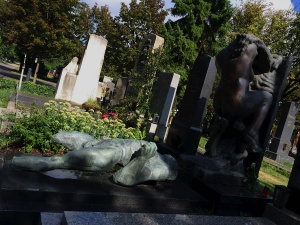Vienna Off The Christmas Markets: 11 Dark Spots You Should Know Of

Sacher Torte isn’t the darkest side of Vienna. Some insider travellers who have roamed Christmas markets, indulged in cakes and watched a Mozart opera end up unearthing its dark past. Right in time for winter’s long nights and deep thoughts, here is a non-exhaustive list of what to do in Vienna for dark culture and history buffs.
Catacombs of St. Stephen’s Cathedral
Trampling on top of a mass grave isn’t what tourists intend when visiting St. Stephen’s Cathedral. Yet, just a few meters below the gothic landmark an eerie ossuary piles up 500-year-old bones and skulls from 10,000 skeletons. Originally, the catacombs represented the Habsburg Emperors’ family tomb. But it’s the Kaisers’ burial rites that give visitors goose bumps: almost the whole Habsburg pedigree preserve their intestines in the ‘Intestines Burial Chamber’, wrapped in silk cloths and soaked in spirit.
Imperial Crypt
Underworld, to-die-for: When the Catacombs got too busy the Habsburgs ‘settled’ in the crypt of nearby Capuchine church. Expect Imperial-style opulence in a private setting - monumental sarcophagi in bronze and copper, hammered, engraved and richly decorated, with golden skulls wearing the Imperial crown. Notably visitors will find Habsburg celebrities such as Empress Maria Theresia, Empress Sissi and Emperor Francis Joseph there, and former EU parliamentarian Otto Habsburg.
Church St. Augustine
A few meters from the Imperial Crypt is the place that has been closest to the Habsburgs’ hearts: The small church of St. Augustine hosted a series of splendid Imperial weddings and housed the Habsburgs’ private chapel. In a niche of the center nave, 58 polished silver urns bear the preserved hearts of Habsburg Emperors and Empresses.
Central Cemetery
Traditionally, Viennese love ‘a schöne Leich’ (a beautiful funeral). Resembling an open air art museum, the Central Cemetery lines up the most amazing graves. Visitors can pay their respects to musicians such as Beethoven, Brahms, Strauss, and Austro pop star Falco. Other than that, it’s simply about exploring Vienna’s special approach to death, beautifully expressed in actor and wine lover Heinrich Schweiger’s grave that regularly stocks two bottles of wine.
That said, there is nothing beautiful about the shocking memorial and graves of victims of the Nazi regime. Around 1,000 resistance fighters were executed and secretly buried here between 1938 and 1945.
Painted Skulls At Natural History Museum
For a behind-the-scenes tour at the Natural History Museum, visitors will encounter hundreds of lovingly painted skulls. Hidden away in the museum’s attic, these skulls demonstrate a centuries-old tradition of Salzburg-based Hallstatt village. To save space, bodies were exhumed 10 to 20 years after their burial and brought into the local ossuary. Local undertakers cleaned and painted the skulls with roses, ivy and other ornaments, as well as the deads’ names.
Funeral Museum
‘Where if not in Vienna to house a funeral museum?’ mused Vienna’s vice mayor when that oddity reopened three years ago. Right underneath the Central Cemetery’s Funeral Parlor 2, visitors can familiarise themselves with the Viennese way of leaving life. Among the highlights are historic objects such as the salvation alarm clock and the heart stab stiletto to avoid being buried alive. Explore the re-usable coffin that was likely used for Mozart’s funeral. And what about bagging a paintable wooden urn with color set from the museum’s shop?
Morzinplatz
Where the history of the Nazi regime starts Vienna’s beautification of death certainly ends. It’s mostly memorials that replace the horror, such as at Morzin square. Blocks of granite from the quarry of former Mauthausen concentration camp remind of the former Gestapo Headquarters, the largest outside of Berlin. Countless Jews and other opponents of the Nazi Regime were held prisoners, tortured and murdered in the basement of former Hotel Metropole.
Path of Remembrance
How do you commemorate thousands of Jewish Holocaust victims? Create stumbling blocks, like the association Stones of Remembrance does across former Jewish district Leopoldstadt. Across the Path of Remembrance you will find some 400 little stones, covered with brass plates, that remind of individuals and pre-deportation camps. Many relatives of murdered family members donated stones in remembrance of their loved ones.
Nazi Victims’ Memorial Spiegelgrund
Nazi cruelties knew no boundaries as Spiegelgrund at Otto Wagner Hospital shows. 772 light steles each remind of one child. During the Nazi regime, the hospital compound was used as a ‘Youth Welfare’ institution. In the name of racial hygiene, the National Socialists performed cruel experiments on children, many of which died there. Pavilion V houses an exhibition of Nazi medicine, its racial theory and the systematic murdering of ‘unworthy lives’. I made it almost half way through.
World War II Defence Towers
Unbelievably at first sight, those utterly unattractive buildings are landmarked. Rather than crowning a city break, Vienna’s six FLAK Towers cut a swathe of dark memories across Wien’s old-world charm. During the last months of the war, these gigantic steel and concrete cylinders helped to fight off air raids while providing shelter to the public. Today, the most famous FLAK tower houses Vienna’s aquarium ‘Haus des Meeres’, as well as a rooftop café offering great panoramic city views. A small exhibition space leads through the building’s history.
Third Man Sewer Tour
There is only one reason tourists would itch for Vienna’s city sewers. If they wanted to follow ‘The Third Man’ (Orson Welles) during his cat-and-mouse game with the Viennese police in Carol Reed’s eponymous movie, hold your nose and lower yourself into the original film locations underground. Not only the sewer system but the whole 1949 movie is dark: Set in post war Vienna the thriller highlights devastation, misery, black market, corruption and murder. Guided tours take place regularly.

